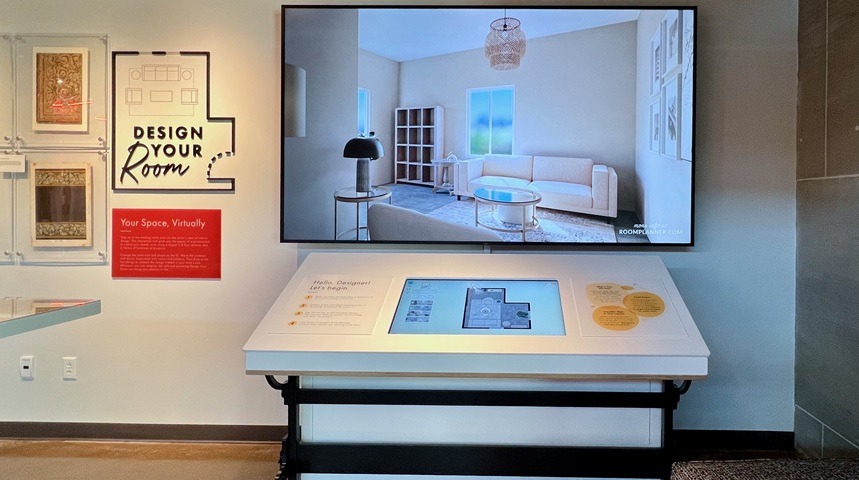HIGH POINT — New digital imaging technologies are playing a central role in the innovation ecosystem that is redefining possibilities for furniture retail, with solutions providers continually improving these technologies to address brick-and mortar specific pain points in the customer journey.
With both the tools themselves and the challenges they aim to solve in a constant state of flux, mapping the near- and medium-term future is tricky. However, several notable trends offer clues as to where things could be headed for traditional furniture retail.
An uneven impact
In contrast to the widespread and ongoing impact these tools have had on furniture e-commerce, the influence of new digital imaging technologies on brick-and-mortar retailers is still in its early stages and varies across different industry segments.
Big-box retailers, with the resources to trial-run and implement digital tools at scale, have been experimenting with them for years. Lowe’s and Ikea have both explored VR and AR, with the latter creating an interactive showroom using in-store Oculus Rift headsets.
Michal Stachowski, co-founder and chief visualization officer at 3D imaging provider Intiaro, noted that the ability of these new tools to smooth out rough spots in the customer experience is not limited to e-commerce.
“These tools allow any customer to remove doubts that may arise in their purchasing journey. They assist in the decision-making process and make the shopping experience interesting and engaging,” he said.
Intiaro offers a kiosk-style 3D design board, with one in permanent residence at the Home Furnishings Hall of Fame and several retailers testing the technology in their stores.
Stachowski believes that, by using technology such as his company’s kiosks, traditional retail can reap many of the same benefits that e-commerce has seen with these tools, including “higher sales conversion rates for all items — especially complex and custom items — higher average order values, and higher overall sales.”
There is also an additional intangible ROI in terms of customer satisfaction, brand perception and a competitive edge. “When customers have seen the item in the fabric, configuration and setting of their target environment, returns naturally drop,” he added.
In addition to the upfront cost of implementing these tools in-store, other constraints hinder their widespread adoption, particularly by small retailers who often lack a large sales staff and in-house design teams.
Preet Singh, founder of the 3D visualization technology platform Imagine.io, notes that the unwieldy nature of the hardware is a key, albeit temporary, limitation.
“VR headsets like Meta Quest and Apple Vision Pro are early prototypes of a future we can imagine,” he said. “Currently, the main thing that stands in the way of their mass adoption is their bulky size. As hardware continues to improve, becoming smaller and fitting into glasses or lenses, we will see massive adoption of these devices.”
Singh added that these developments would eventually enable dynamic and easily customizable merchandising experiences, including the “creation of interactive retail spaces that represent the brand’s vision.”
Make it easy
Ease of use, for both customers and employees, is another overarching “must-have” for these tools to make a bigger impact on traditional brick-and-mortar retail in the future.
Mark Hewett, the owner and founder of Area Modern Home, a Greensboro, N.C.-based brick-and-mortar retailer with two locations and two sales staff, said he would be interested in exploring the merchandising and customer engagement possibilities of these tools, provided the price was right and a few other factors fell into place.
“I’d love for customers to be able to see the item in their own space and get product recommendations, but it’s got to be easy to use,” Hewett said.
He added that these tools could potentially have value as an aid to a specific kind of high-consideration customer toward the upper end of the market.
“We never try to sell customers something they don’t want,” he said. “We’re the type of place that, if they’re not 100% sure, we tell them to maybe go away and think about it. It’s better to have someone happier than for them to get something they don’t need.
“It costs us business, and we’ve talked ourselves out of business before,” Hewett said, adding that a tool that increases customer confidence could address this pain point.
All the kinks in the customer experience that new digital imaging technologies can help brick-and-mortar furniture retailers address arise from a simple, inescapable fact: Customers are only human, and humans waffle, second-guess, change their minds and have entirely subjective tastes.
At the end of the day, deploying 3D imaging tools in-store is about giving customers the space to explore what works and what doesn’t while simultaneously creating an engaging merchandising experience that can drive sales.
